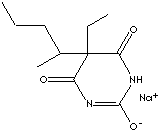| CAS
NO. |
76-74-4
(Parent), 57-33-0 (Sodium salt) |

|
| EINECS
NO. |
200-983-8, 200-323-9 |
| FORMULA |
C11H17N2NaO3 |
| MOL
WT. |
248.25 |
|
H.S.
CODE
|
|
|
TOXICITY
|
|
| SYNONYMS |
Ethyl-5-(1-methylbutyl) barbituric acid sodium salt;
|
| 5-Ehyl-5-(1-methylbutyl)-2,4,6(1H,3H,5H)-primidinetrione monosodium salt;
5-Ethyl-5-(1-methylbutyl)-2,4,6(1H,3H,5H)-pyrimidinetrione monosodium salt;
Auropan; 5-Ethyl-5-sec-pentylbabituric acid sodium salt; Barpental; Biosedan;
Butylmethyl ethyl malonyl urea sodium; Butylone; Continal; Diabutal; Embutal;
Etaminal sodium; Ethaminal sodium; Euthanyl; Euthatal; Isobarb; Lethobarb;
Mebubarbital sodium; Mebumal sodium; Mebunat; Mintal; Napental; Nembutal sodium;
Pacifan; Palapent; Penbar; Pental; Pentalbarbital sodium; Pentobarbitone sodium;
Pentonal; Pentone; Pentosol; Propylmethylcarbinylethyl barbituric acid sodium
salt; RS-Pentobarbital sodium; Rivadorn; Sagatal; Sodium
5-ethyl-5-(1-methylbutyl)barbiturate; Sodium ethaminal; Sodium nembutal; Sodium
pentobarbital; Sodium pentobarbitone; Sodium pentobarbiturate; Sodium-Pent;
Soluble pentobarbital; Somnopentyl; Sonistan; Sontobarbital nabitone; Sopental;
Sotyl; Vetbutal; Other CAS RN: 10579-81-4; 23714-57-0; 8023-11-8; 8050-99-5;
|
|
DERIVATION |
|
|
CLASSIFICATION
|
|
|
PHYSICAL
AND CHEMICAL PROPERTIES
|
| PHYSICAL
STATE |
white
to pale yellow crystalline powder |
| MELTING
POINT |
|
| BOILING
POINT |
|
| SPECIFIC
GRAVITY |
|
| SOLUBILITY
IN WATER |
Soluble |
| pH |
|
| VAPOR
DENSITY |
|
| AUTOIGNITION |
|
| NFPA
RATINGS |
|
|
REFRACTIVE
INDEX
|
|
| FLASH
POINT |
|
| STABILITY |
Stable
under ordinary conditions. |
|
GENERAL
DESCRIPTION & APPLICATIONS
|
Barbituric acid, chemically 2,4,6-trioxohexahydropyrimidine, a cyclic amide used as the parent compound
to produce barbiturates that act as central nervous system depressants.
Barbituric acid itself does not give sedative and hypnotic effects but the
substituted derivatives with alkyl or aryl group at position 5 provide effects.
Thiobarbituric acid, replaced oxygen atom of the urea component by sulfur, the
parent compound of the thiobarbiturates which resembles the barbiturates in its
effects. Barbiturates are drugs that acts as sedative-hypnotic agents. The
short-acting barbiturates such as thiopental are used as intravenous
anesthetics. The long-acting barbiturate such as phenobarbital is an
anticonvulsant used in the treatment of epilepsy. They are used for the
suppression of anxiety, the induction of sleep, and the control of seizures.
Commercially available barbiturates are;
- Amobarbital
- Aprobarbital
- Butabarbital
- Butalbital
- Hexobarbital
- Mephobarbital
- Pentobarbital
- Phenobarbital
- Secobarbital
- Talbutal
- Thiobarbital
- Thiopental
Pentobarbital a short-
to intermediate-acting barbiturate
used as a sedative particularly as a presurgical adjunct to anesthesia and as
a hypnotic (but not
as an anti-anxiety)
It is prescribed more
frequently for sleep induction than for sedation but, like similar agents, may
lose its effectiveness by the second week of continued administration. It enhances GABAergic activity
It is used as an
anticonvulsant for emergency treatment of acute convulsive episodes. It is usually administered orally
but also intramuscularly, intravenously, and rectally. Pentobarbital
molecules include;
|
Product
|
CAS
RN.
|
| Pentobarbital sodium |
57-33-0 |
| Thiopental sodium |
71-73-8 |
| Cyclopentobarbital
|
76-68-6 |
| Pentobarbital |
76-74-4 |
| Thiopental |
76-75-5 |
| Cyclopentobarbital sodium
salt |
302-34-1 |
| 3'-Hydroxypentobarbital
|
4241-40-1 |
| Pentobarbital calcium
salt |
7563-42-0 |
| Pentobarbital and
carbromal |
8065-30-3 |
| R-(+)-Pentobarbital |
21045-50-1 |
| S-(-)-Pentobarbital sodium |
21642-82-0 |
| R-(+)-Pentobarbital sodium |
21642-83-1 |
| RS-Pentobarbital sodium |
23714-57-0 |
| N,N'-Dimethylpentobarbital |
28239-47-6 |
| N-Methylpentobarbital |
57562-99-9 |
| Methylcyclopal |
64810-92-0 |
| N,N-Diallylpentobarbital
|
95575-11-4 |
| N-Allylpentobarbital
|
99683-86-0 |
| N,N'-Diallylpentobarbital |
99696-88-5 |
| N-Allyl-N'-methylpentobarbital |
106463-25-6 |
| 1-(Glucopyranosyl)pentobarbital
|
147839-07-4 |
|
| SALES
SPECIFICATION |
|
APPEARANCE
|
white
to pale yellow crystalline powder |
|
IDENTITY
(IR)
|
pass
|
|
PURITY
(G.C.)
|
98.0
- 102.0%
|
|
LOSS
ON DRYING
|
3.0%
max
|
|
HEAVY
METALS
|
20ppm
max
|
|
RELATED
MATERIALS
|
to
pass test
|
|
VOLATILE
MATERIALS
|
to
pass test
|
| TRANSPORTATION |
| PACKING |
|
| HAZARD
CLASS |
6.1
(Packing Group: III) |
| UN
NO. |
2811 |
| OTHER
INFORMATION |
| Hazard Symbols: T, Risk Phrases: 25, Safety
Phrases: 45 |
| PRICES |

|
